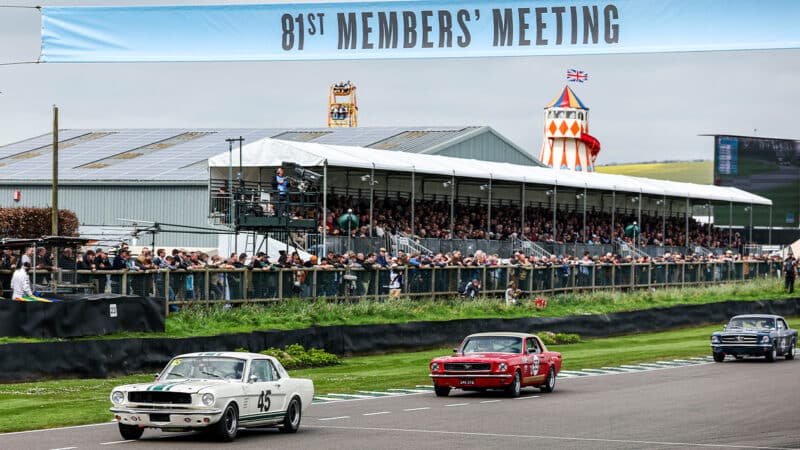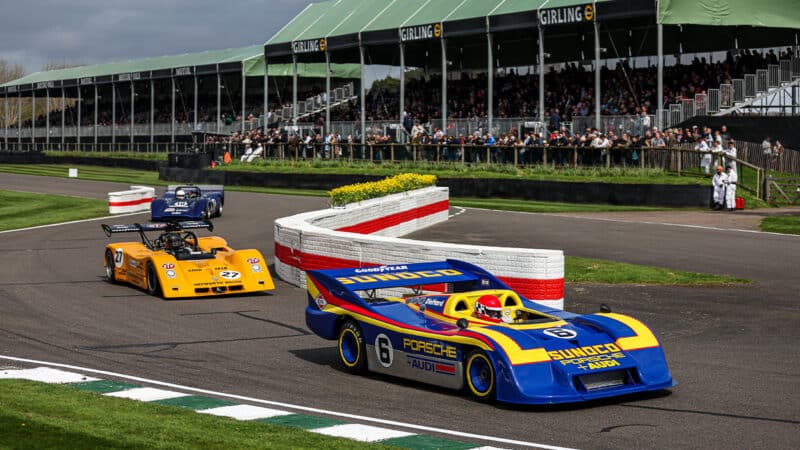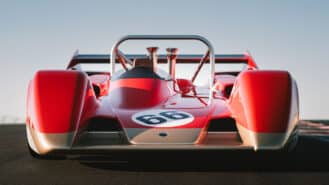In a static display was the stillborn Lotus Type 66, Colin Chapman’s dream realised by Lotus Advanced Performance last year and I cannot do better that steer you to James Elson’s excellent article on this website last August. Another rarity was the so-called Alan Mann-built, Len Bailey-designed Open Sports Ford with the now unretired David Brabham at the wheel. Porsche brought its lurid 917/30 for factory driver Timo Bernhard to demonstrate while Peter Harburg brought his 917/30, which was the Penske spare and never raced.
Of course, the demonstration was bittersweet as it was here nigh-on 54 years ago that Bruce McLaren was killed testing in the M8D Can-Am car. Indeed, sympathetically, there wasn’t an M8D in the demo but there were M6s, an M8C, a customer M8E, with ex-McLaren employee Warren Biggs at the wheel, an M8F and the 1972 M20, which didn’t run on track.
Two Formula 1 demonstrations reminded us of the beauty and visceral nature of 1980s Grand Prix cars. Former McLaren chief road car tester Chris Goodwin drove Niki Lauda’s 1985 Porsche-powered MP4/2B and it was great to see Gerhard Berger at the wheel of his 1989 Ferrari 640 now owned by Egon Zweimuller Jnr. It was the car in which Berger won the 1989 Portuguese Grand Prix. Bring back naturally aspirated 3-litre V12 engines, say I.
Former Indy winner Dario Franchitti is now very much a part of the Goodwood experience and is now one of the four house captains in the tongue-in-cheek, public school competition which seems to cover everything from a tug of war to the race results. More seriously Franchitti demonstrated the latest Gordon Murray design – the GMA T.50s Niki Lauda. Only 24 of these track day cars will be produced and each chassis will be nicknamed after a track where Niki won. Dario demonstrated the 770bhp Cosworth powered machine. This, the first off the line, is called Kyalami. In the paddock GMS also had a great display of cars designed by Gordon including a Brabham BT44.
Goodwood always looks after the two-wheel brigade and the Yamahas, Honda and Triumphs had two thrilling races, as did the one-off innovation of the Sidecar Shoot-Out. Eight of the three-wheelers had been assembled, mainly LCR-Yamahas. It was the Swiss Louis Christen who shook up the sidecar world 50 years ago with their innovative monocoque chassis, raced so successfully by Rolf Biland. As far as I could see the design had plateaued out after that although they have seriously more power.
The knock-out sprint style Shoot-Out served to remind us that Sidecars were for many years an intrinsic part of the World Motorcycle Racing Champion and British riders excelled with World Champions including Eric Oliver (with the great DSJ of Motor Sport as his passenger), George O’Dell, Jock Taylor and multi-champion Steve Webster. The format saw each pairing take to the track on a warm-up lap, flying lap and cooldown lap before the next team set their time. While entertaining to watch the obviously on-limit performances, it did take a little too much track time.
S.F. Edge Trophy
So to the main course with the first actual car race of the weekend starting a just after 6pm after a packed day of practice. This was the always-popular S.F. Edge Trophy for Edwardian and Aero-Engined specials in the spirit of Brooklands prior to 1923, although the youngest car was actually built in 1916 and a couple some 120 years old.
Last year the two Edwardian races each saw the same pattern at the start: Mark Walker in a 1905 200 hp, 22.5 litre, two-gear land speed record Darracq was slow off the line due to its gearing. On both occasions in the closing seconds of the race he swept by Julian Majub’s 1916 Sunbeam Indianapolis to win. Would history repeat itself? Not quite. Again the stripped down Anglo-French machine was very slow away and dropped to about 11th place. But this time it was the Blockley Tyre Company boss who hung on to win by 2.2sec. As he was 12 months ago, Ben Collings was third in his 1907 Mercedes.
Gordon Spice Trophy
The second and final Saturday race was the Gordon Spice Trophy for Group 1 saloons that raced between 1970 and 1982, so unlike last year when the race was split into two capacity divisions, everyone raced together but got two races. Some Minis – with Nick Swift set to humble some of the larger tin tops – through Dolomites, Rover 3500s, plenty of Capris and some potentially very quick US muscle cars, both Camaros and Mustangs. This 45min race featured both owners and some great pro drivers with Sunday’s shorter reserved for the owners.
It was something of a surprise to see Le Mans winner and Goodwood debutant Timo Bernhard drafted in to join Mustang ace Fred Shepherd who set pole position. Bernhard took the start, and he powered into the lead while James Thorpe in the Camaro Z28 catapulted into second place “more by luck than judgement”.
At third distance the German came in to hand over to Shepherd the lead as the pit window opened, as others followed, a car stopped on course which brought out the course car. It took a few minutes to clear up and played into the hands of the late-stopping Craig Davis Boss Mustang, which had started eighth. He handed over to reigning and four-time BTCC Champion Ash Sutton, with the pack behind shuffled.
Ash was able to inch the Mustang away from a great battle between the Camaros to win by 2.4 seconds. The Shepherd/Bernard car made it a Mustang one-two with Gordon Shedden (who took over the Jack Young Camaro) making a great pass to vault past Dario Franchitti (sharing with James Cottingham) to finish third. There were Camaros in the next three places before the Rover of Michael Whitaker and Tom Ingram.
Parnell Cup
Sunday’s action started early – 9am on the dot — with the Parnell Cup for Grand Prix and Voiturette cars that raced between 1935 and 1953. The 1953 T23 Cooper-Bristol was predominant with five entries including Will Nuthall, who on paper looked the clear favourite although it was good to see John Ure back in the ex-Tony Crook two-seater Cooper-Bristol. They lined up on the front row with the Kieft-Climax of Nigel Batchelor, which has raced in period both as a voiturette and a sports car.
It was Ure who got the jump at the start over Nuthall and the pair then staged a wheel to wheel battle for the first half of the race when the Nottingham racer made a pass that stuck. He was then able to pull away in Anthony Helliwell’s car raced mainly in period in Australia. But Will got caught in traffic on the last lap and Ure so nearly passed him at Woodcote on the last lap to take his third successive Parnell Trophy victory. Will’s Dad Ian took third place in his Cooper-Bristol, holding off the recovering Batchelor.
Derek Bell Trophy
Next up a race I was really looking forward and a category rarely seen at any major meetings – the Derek Bell Trophy for 1000cc Formula 3 cars from 1964 to 1970. Some 30 of the 1-litre “screamers & slip-streamers” were on hand in a great start to their 60th anniversary year. Simon Etherington of the 1-litre Formula 3 Association had worked hard to secure this race, returning to the meeting after a break of a year, and the screamers didn’t disappoint.
With last year’s champion Samuel Harrison moving on to greater things, 2016, 2017 and 2022 winner Mike Hibberd in the family Brabham BT18 was surely the man to beat although lurking on the entry list were two cars and drivers not normally seen on 1-litre F3 entry lists. Nick Padmore in Ian Bankhurst’s ex-Terry Ogilvie-Hardy Alexis and McLaren factory GT racer Michael O’Brien was in Speedsport’s just renovated Titan Mk3.
O’Brien, no stranger to 50 year-old single-seaters, served notice by putting the ex-Dave Brodie factory car on the pole but outright Goodwood lap record holder Padmore suffered from a distributor problem (remember those!) and only qualified 11th. The car promptly blew up on the warm-up lap, while former winner here John Milcevic in the Brabham BT21B was a last minute non-starter. Derek Bell was on hand to lead the field around the formation lap in the ex-Jackie Stewart Cooper-BMC T72.
At the start it was Peter de la Roche in the yellow ex-Dick Barker Alexis Mk17 who took the lead. But after a sluggish start O’Brien took the lead on lap 2 with Andrew Hibberd in the Brabham inches behind in third. Behind there were several off-course but non-damaging incidents but then we had a red flag when 2022 Champion Jeremy Timms crashed heavily in his ex-factory Chevron B15 at Madgwick.
At the re-start O’Brien made a poor start but quickly made a great pass on de la Roche and Hibberd who then staged a terrific scrap for second. O’Brien ran to an eight second win with Hibberd’s ex-Chequered Flag team Brabham inches ahead of the Alexis with Jason Tibbs fourth in his Brabham BT21.
Surtees Trophy
Next up was the Surtees Trophy for sports-prototypes that raced between 1960 and 1964. So quite a small window but one that embraced mainly early Can-Am cars and GT40s, as well as 2-litre GT cars that consisted mainly of Chevron B8s. Although 73-year-old Bestinvest founder John Spiers put his 1965 McLaren M1C Can-Am car on the pole there were two of the nimble B8s alongside him with Ben Mitchell fractionally faster than Andrew Kirkaldy. Alex Brundle started tenth after fuel pump problems with his Mk1 7-litre Ford GT40 replica looked after by his new Brundle Motorsport preparation company.
Kirkcaldy clearly jumped the start to take the lead but cop a ten-second penalty, then lost the position to Spiers who had built a 12sec gap when, with two laps to go, he clashed with Joachim Foch’s GT40 while lapping to him and spun.
Brundle powered his way up to second place only to slow and retire with a fuel pump problem. Kirkcaldy crossed the line first after a great battle with Ben Mitchell who only realised with a lap to go that Kirkaldy had a penalty, so another Chevron win for Mitchell. Spiers recovered to second and third place was claimed by Ian Simmonds in the ex-Mecom Racing Team Lola T70. Kirkcaldy’s penalty dropped him to fourth.
Ken Miles Cup
Completing the morning’s races was another of Goodwood’s firsts, the Ken Miles Trophy for Ford Mustang Notchbacks from 1965. Who would have thought they could muster 30 of these V8 beasts. Miles’s name was on the Trophy, commemorating the Birmingham engineer and racer, so well portrayed by Christian Bale in the Ford v Ferrari / Le Mans ’66 film gave the Mustang its first major win.
This was a two-driver race 45 min race and with no previous form it was difficult pick a winner but it did include drivers of the calibre of Tom Kristensen, David Brabham, Andy Priaulx – a winner to remember in the E-type at the Revival last year – and several BTCC stars past and present including Rob Huff, Jake Hill, Gordon Shedden, Ash Sutton, Anthony Reid and Steve Soper. Add to that the Chairman and CEO of the Ford Motor Company Jim Farley, plus three-time W Series Champion Jamie Chadwick and you had an impressive line-up.
On pole was the Craig Davies /Darren Turner car with Davies behind the wheel. It headed the field but was soon passed by Fred Shepherd before a stranded car briefly brought out the safety car on lap three. Shepherd continued to lead until he handed over to last-minute guest driver Timo Bernhard. Pushing hard, Andy Priaulx was second in the car he shared with Alex Taylor.
The driver also brought a reshuffle in the order. After the pitstops, it was Andrew Jordan in a new JRT-built car leading, having taken over from owner Mike Whitaker. After his win on Saturday Ash Sutton blotted his copybook when he charged the chicane and scattered the daffodils. Once they were re-potted, Jordan managed to hold onto the lead but behind there were some great battles with various front runners hitting late problems. At the flag, David Brabham/Alex Brundle took second from Jake Hill and Rob Fenn who had started sixth. Potential podium finishers Bernhard/Shepherd, Shedden/James Thorpe hit mechanical problems near the end. So fourth was Davies/Turner from Priaulx/Taylor.
S.F Edge Trophy, Race 2
The afternoon action commenced with the second S.F Edge Edwardian 5-lapper. Could Taylor make a better start this time? The answer was yes and this time he did make it past Julian Majzub’s Sunbeam on the last lap to take a win for the outrageous machine.
Graham Hill Trophy
The Graham Hill Trophy for closed cockpit GT cars that raced here up to 1966 looked like a Cobra, E-type battle with possible interventions from a couple of TVR Griffiths. A few nimble Elans 26Rs might also be near the front although star Elan man Giles Dawson wasn’t on the list.
Miles Griffiths is a past Goodwood winner but I don’t think he has ever previously raced a Griffith. That made little difference as he powered the TVR to a two-second victory over Alex Buncombe’s Cobra with Mike Whitaker’s well known Griffiths in third place ahead of another Cobra and two Bizzarrinis.
Grover-Williams Trophy
It was back to the Pre-War next for the Grover-Williams Trophy for early 1920s Grand Prix cars which, apart from four interlopers was all Bugattis from the Type 35B – spanning earlier models to the later version that William Grover-Williams drove to victory in the first ever Monaco GP, held in 1929.
Julian Majzub, now in his Type 35B, pulled away from the field to score his second win of the weekend. He was 6.8sec ahead of Duncan Pittaway’s older Type 35 as Tim Dutton’s fast Type 51 retired. Tim Croughton broke up the French dominance with third spot in his 1925 Fraser Nash.
Peter Collins Trophy
It was back to sports cars for the penultimate race – the Peter Collins Trophy for sports racers from 1948 to 1955 with a very eclectic mix which embraced earlier Jaguar D types, Richard Wilson’s £2m Maserati 250D and even Dr Ernest Nagamatsu in the Buick powered Old Yeller Mk2 Old built by Hollywood hot-rodder Max Balchowsky. There was superb wheel-to-wheel action early on with John Pearson in his finless 3.4 D-type swapping the lead with the Maserati. But at half distance he retired to the pits. Fred Wakeman came through for second spot in his Jaguar C-type. But man of the race was definitely young Jack Rawles in his humble Austin Healey 100S. Early on he was on the tail of the Maserati and D-type and eventually he came home third – his first Goodwood podium.
Gordon Spice Sprint
Bringing another superb Members’ Meeting to a close was the second half Gordon Spice Trophy Group 1 saloon race this time a 15min Sprint with a reverse grid. It put the Minis at the front, and they held position at the start, running three abreast to confound the faster Camaros behind. Seconds later, however, the formation came to an unfortunate end as one Mini was tapped by a Rover, skidded off and then back on to the track, colliding with the Rover that had begun the sequence. That brought an early red flag. At the restart, the US muscle cars were through by the end of the first lap. Some frantic action saw Jack Tetley lead Fred Shepherd until the Boss Mustang man passed the Z28 Camaro. So in what had been a great weekend for the Shepherd family, he headed home James Cottingham in David Clark’s Camaro, with Craig Davies third and Tetley fourth.
It was a fitting end to a weekend of entertaining racing served with style, and almost the perfect way to begin the historic racing year. My one caveat is that I’d like to see a race with slightly more modern machinery — perhaps one for next year’s refreshed menu.



